Elgin leak poses massive challenge
- Published
- comments
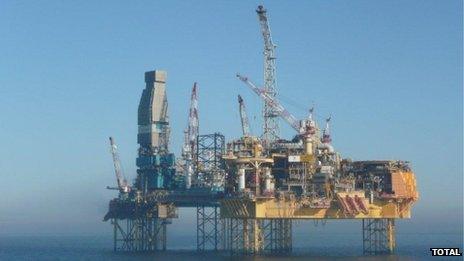
The situation at the Elgin rig is still not under control
An uncontrolled release of fossil fuel out in the ocean. An oil giant's share price tumbling. A frantic search for techniques to shut off the leak. Sound familiar?
A visit to Aberdeen on Thursday prompted the question of parallels between Total's struggle at its Elgin rig and BP's battle with a blowout at its Macondo well in the Gulf of Mexico in 2010.
Let's start with the leak itself. Total says it has identified the source: that gas from a deep reservoir is somehow flowing into a part of the underground well system.
The pipework is allowing the gas to reach the surface. And it is then venting into the air at deck-level on the rig.
But they cannot be entirely sure because no one is on the rig to check.
Thursday night's statement from the Department for Energy and Climate Change, external seems to take account of this.
It speaks of "using the best data currently available" - which will not be comprehensive.
It says: "Total believes the gas is being released from the well system" - not that it knows for sure that this is the case.
The entry of the gas into the well system "has been estimated at a point 4,000m below the seabed" - in other words, not established for certain.
The fact is that with observations being made from a distance, even experts can make only informed estimates about precisely what is going on: not just at the unmanned surface but also amid the geological labyrinth of rocks and reservoirs under the sea.
Initial confusion
Here there is a similarity with the BP experience. In the early days of the blowout, there was confusion.
Initially, it was reported that there might not be a leak at all. Then that oil was gushing from a single rupture.
Later, that was 'clarified' to mean several breaks in the pipework.
Only when remotely-operated vehicles (ROVs) were despatched to the depths did a clearer picture emerge of a tangled and complicated mess.
Total will be hoping that it can establish a sharper image of the underground plumbing.
Best way forward
Next, tactics. Total is weighing up its options. The most attractive is also the most dangerous: blocking the well with 'drilling mud', pumping in heavy fluids to seal the well and prevent the gas from escaping.
This is attractive because it could be carried out relatively quickly using the existing infrastructure of the rig.
But it is also dangerous because the work can only be undertaken if engineers are sent on board.
And no one can risk going onto the rig while its gas flare is still burning.
The flare was reportedly showing signs of diminishing on Thursday - but no one knows how long it will remain alight. It cannot be switched off remotely.
The wind is blowing the gas cloud away from it at the moment.
And the gas tends to sink towards the sea while the flare is 100m high. But still, who would want to get too close?
Hence the discussion of trying to snuff the flare out with water dropped from a helicopter or using sprays from fire-fighting vessels.
But it would take a brave helicopter pilot to hover low enough for an accurate drop.
Fukushima experience
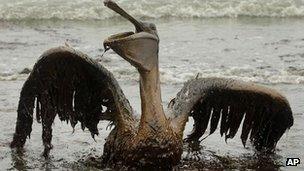
The BP oil spill washed up on the US coast
Remember how a similar move was tried in Japan last year to cool the Fukushima nuclear reactors.
Needing to stay high to avoid the worst of the radiation, most of the crews missed.
In the North Sea they would also want to keep a safe distance to avoid igniting the gas cloud.
The fire fighting ships face the same risk: how to get close enough for an accurate aim without triggering conflagration.
Total knows what it wants to do but cannot get people there to do it.
BP faced a similar frustration: it also could not get people to the scene.
The blowout was in mile-deep water where the pressures were far too great for divers to be deployed.
Clearing the damaged pipework, untangling the wreckage, fixing new connections - all had to be done by robot, which was far slower and more challenging.
And BP's first few attempts to block the leak with drilling mud - a so-called 'top kill' - failed.
I visited BP's 'crisis centre' in Houston at one of the worst moments and sensed the tension of a mighty company humbled by its inability to stop the leak.
Massages for stress
Gone was any of the macho swagger that sometimes characterised oil men.
One of the first sights to catch my eye inside the centre was a notice offering counselling and massages for stress.
What about the leak itself? Luckily for Total, gas is far less damaging than crude oil.
The cloud of methane billowing over the North Sea is a potent greenhouse gas.
But the sheen of gas condensate floating on the surface lacks the viscosity and sheer weight of crude making it far less likely to cause the kind of scenes I reported on along the coast of Louisiana.
Greater impact
But it is possible the impact will become more severe if the leak continues unchecked.
And who knows how long that will take? If the 'top kill' option fails - either because no one can get on board or because the well is more badly damaged than thought - Total will have to resort to the lengthy and expensive option of drilling a relief well.
This is an immense undertaking. The drillers have to push through 4,000m of rock to reach a very particular point to make the interception.
It is not guaranteed. And one other downside: it would take six months.
BP was under such pressure that it felt compelled to drill two relief wells.
In the end the leak was stopped when a good connection was established at the wellhead to allow a successful injection of mud from above.
But that took nearly three months. And BP is still feeling the consequences.
Kuwait parallel
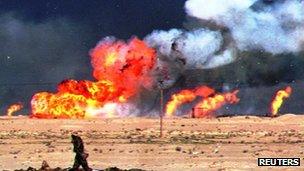
The Iraqi army blew up hundreds of oil wells in Kuwait
The immediate challenge for Total is getting access to the rig.
Which brings to mind another parallel: Kuwait in 1991 when the Iraqi army blew up hundreds of oil wells as it retreated.
It was an apocalyptic scene. The blackened desert was overshadowed by noxious clouds illuminated by giant flares roaring like jet engines.
Our clothes were spattered with crude and the heat from the fires was intense.
Who could possibly deal with such danger? The answer: teams of extremely brave Texans, swaddled in flame-suits and shielded by makeshift armour of corrugated iron.
If those types are drafted in now by Total, we will know it is bad.
- Published30 March 2012
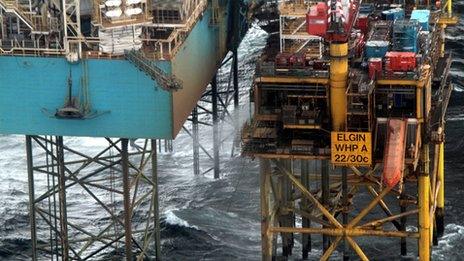
- Published28 March 2012
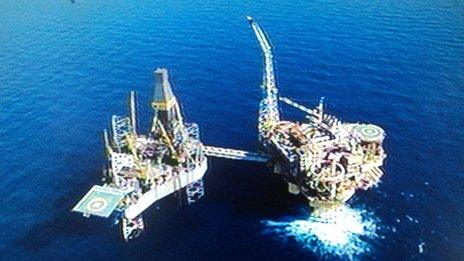
- Published3 March 2012
